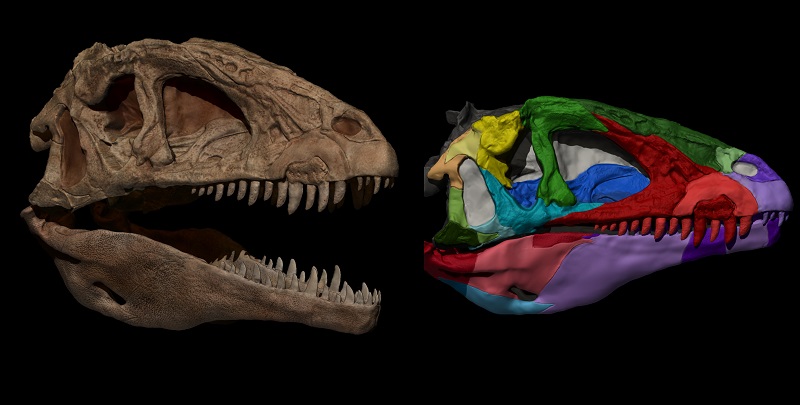
Concavenator Skull Reconstructed

2018-07-31
The study of virtual 3D reconstruction techniques of the skull of Concavenator corcovatus, alias “Pepito”, the famous humpbacked dinosaur from Cuenca, has contributed new knowledge about the Carcharodontosauridae, the line of the great carnivores of the Cretaceous period. Scientists from the Universidad Autónoma de Madrid (UAM) and the Universidad Nacional de Educación a Distancia (UNED) have published the results in the journal, Cretaceous Research
Its recent appearance in Jurassic World: Fallen Kingdom confirms the reputation of the “humpbacked hunter from Cuenca” (Concavenator corcovatus), the carnivorous dinosaur from Cuenca dating back 125 million years.
The Concavenator’s best known characteristics are the presence of a structure resembling a hunchback, as well as bumps on the arm that point to the presence of ancestral quills. “Pepito”, his friends call this this 6-meter, meat-eating dinosaur, is represented by a basically complete, articulated skeleton; a unique fossil that even conserves scales on the feet and tail.
A recent publication in Cretaceous Research presents a complete study of the skull. According to the study, the skeleton of the head is essentially complete, lacking only a few fragments of the snout and back of the skull; damages due largely to the intervention of forestry machinery and the natural formation of diaclases (cracks) in the limestone at Las Hoyas site where the specimen was found.
Despite being practically complete, the study of the cranium is hindered greatly by the compression produced by the sediments. “We could say that it is preserved almost in two dimensions”, the authors state.
3D Reconstruction
The authors of the work, scientists at the Universidad Autónoma de Madrid (UAM) and the Universidad Nacional de Educación a Distancia (UNED), have managed to overcome the issues of conservation with novel and current 3D computer reconstruction techniques.
These techniques make it possible to reconstruct the parts that have been lost and eliminate the distortions caused by compression. In the case of the Concavenator’s skull, the authors used a technique known as photogrammetry, which enables 3D models of the fossil to be obtained.
With these models, the fossilized bone can be discriminated (i.e., virtually eliminate the remains of rock it contains); the volume that was lost during fossilization can be recovered, and the missing or incomplete parts can be recreated.
This modeling is done by comparing the Concavenatoris anatomy with that of other closely related dinosaurs. “In this way, we obtained the digitalized cranium of the Concavenator 3D, which makes it possible to manipulate it and even print it, making it a huge plus for research and museums”, the scientists pointed out.
Carcharodontosauridae
3D technology –together with classical comparative anatomy study of fossil remains of other related dinosaurs– enables a complete osteological analysis to be performed, yielding results that are relevant to the understanding of the evolutionary history of carcharodontosauridae.
Carcharodontosauridae are a group of large theropods that inhabited most regions around the world during the Cretaceous. Their ecological role can be compared to the famous tyrannosaurids; both being super predators.
“This new study of the Concavenator’s cranium provides relevant information in our knowledge about the cranial structure of the large, carnivorous dinosaurs. In the lineage of the carcharodontosauridae, the case of Concavenator shows that these predators developed a skull that was specialized in eating prey, for at least 125 million years”, the authors conclude.
_____________________
Bibliographic Reference:
Elena Cuesta, Daniel Vidal, Francisco Ortega, José L. Sanz (2018). The cranial osteology of Concavenator corcovatus (Theropoda; Carcharodontosauria) from the Lower Cretaceous of Spain. Cretaceous Research in press..
Contact:
Dr. Elena Cuesta Fidalgo
Paleontology Unit
Department of Biology
Universidad Autónoma de Madrid
E-mail: elena.cuesta@uam.es
Web: https://www.researchgate.net/profile/Elena_Cuesta

